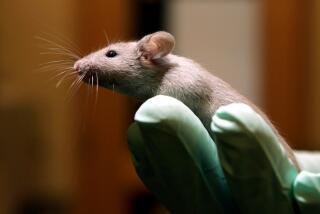Scientists Report Cloning Adult Mammal
- Share via
In an unprecedented feat, Scottish scientists have cloned an adult mammal by inserting DNA from a single sheep cell into an egg, implanting it in a surrogate mother and raising it to adulthood.
They now have a healthy, 7-month-old sheep named Dolly--an exact genetic duplicate of the animal from which the single cell was taken. Six other clones have been produced using the same technique.
The remarkable feat has been considered by many scientists to be impossible because of the technical difficulties involved in nurturing the DNA and prompting it to grow into an intact organism.
Many more scientists have considered it an ethically dubious goal because the achievement theoretically opens the door to cloning humans, a possibility fraught with moral ambiguities. Its achievement seems likely to spark an intense debate about the ethics of genetic engineering research in humans. But experts agree that, however the debate is resolved, the genie is irretrievably out of the bottle.
Based on the data to be presented in Thursday’s edition of the British journal Nature by embryologist Ian Wilmut and his colleagues at the Roslin Institute in Roslin, Scotland, experts said that virtually any competent scientist should be able to reproduce the results.
But the feat should also have marvelous applications in agriculture and human medicine as well. Researchers should, for example, quickly be able to clone so-called super-producing cattle--cows that produce 40,000 pounds of milk per year instead of the more normal 30,000 pounds.
The technique should also speed up the process of genetically engineering animals so that they produce valuable human medications in their milk, a process that could lower the cost and increase the supply of such valuable materials as the clot-dissolving tPA used to treat heart attacks and strokes.
Researchers could also more easily develop animals with human diseases to help scientists pick apart disease mechanisms and provide for rapid screening of new treatments.
“What this will mostly be used for is to produce new health care products,” Wilmut told Britain’s Press Association news agency Saturday. “It will enable us to study genetic diseases for which there is presently no cure and track down the mechanisms that are involved.”
But he added that laws should be enacted to prohibit cloning humans. “It would be desperately sad if people started using this technology with people,” he said.
But others argued that such laws will prove useless. “This technology is not, in principle, policeable,” ethicist Ronald Munson of the University of Missouri at St. Louis told the New York Times.
Others noted that similar efforts had been made to legally block in vitro fertilization. But when Britain and other countries banned it, researchers simply fled to Singapore and other countries to continue their work.
The idea of cloning humans has fascinated scientists since the dawn of the genetic engineering era more than 25 years ago. As early as 1978, journalist David Rorvik stunned the world with “In His Own Image: The Cloning of a Man,” which purported to be the true story of a billionaire’s quest to produce a son identical to himself.
Other notable fictional efforts have included “Joshua, Son of None,” by Los Angeles-based author Nancy Freedman, about the cloning of John F. Kennedy, and Ira Levin’s “The Boys from Brazil,” about the cloning of Adolf Hitler.
Science, however, lagged well behind fiction. About the best that genetic engineers have been able to do in the past is produce identical carrots. Some researchers thought they had made progress in cloning frogs, but the tadpoles produced in the cloning process died before transforming into adults.
The problem is that the DNA in an embryo is not the same as the DNA in an adult, because it changes during growth. In a mammalian skin cell, for example, those portions of DNA that are not needed in skin are shut down. Scientists have argued whether those segments are simply placed into storage or permanently altered so that they no longer function.
Wilmut’s work is clear evidence that the former is the case and that the DNA is capable of casting off the shackles that lock it into a specific cell type.
The simple secret, Wilmut found, is to put the donor cell to sleep. He and his colleagues treated the cell so that neither the DNA nor the cell itself were dividing. When the nucleus of such a donor cell is then placed into an egg whose own nucleus has been removed, it magically starts dividing again.
Early last year, Wilmut’s team took an udder cell from an adult ewe, treated it with their new protocol and inserted the newly created embryo into a surrogate mother. In July, the mother gave birth to Dolly, who is now 7 months old and seemingly perfectly healthy.
DNA tests show that Dolly is identical to the ewe who donated the udder cell and is unrelated to the surrogate mother.
Wilmut has now accomplished this feat seven times, using DNA from other fetal and embryonic sheep. Those results, which had not been achieved by other researchers, indicate that this is clearly a viable technology and not merely a one-time fluke.
His next goal, he said Saturday, is to clone cattle.
More to Read
Sign up for Essential California
The most important California stories and recommendations in your inbox every morning.
You may occasionally receive promotional content from the Los Angeles Times.













